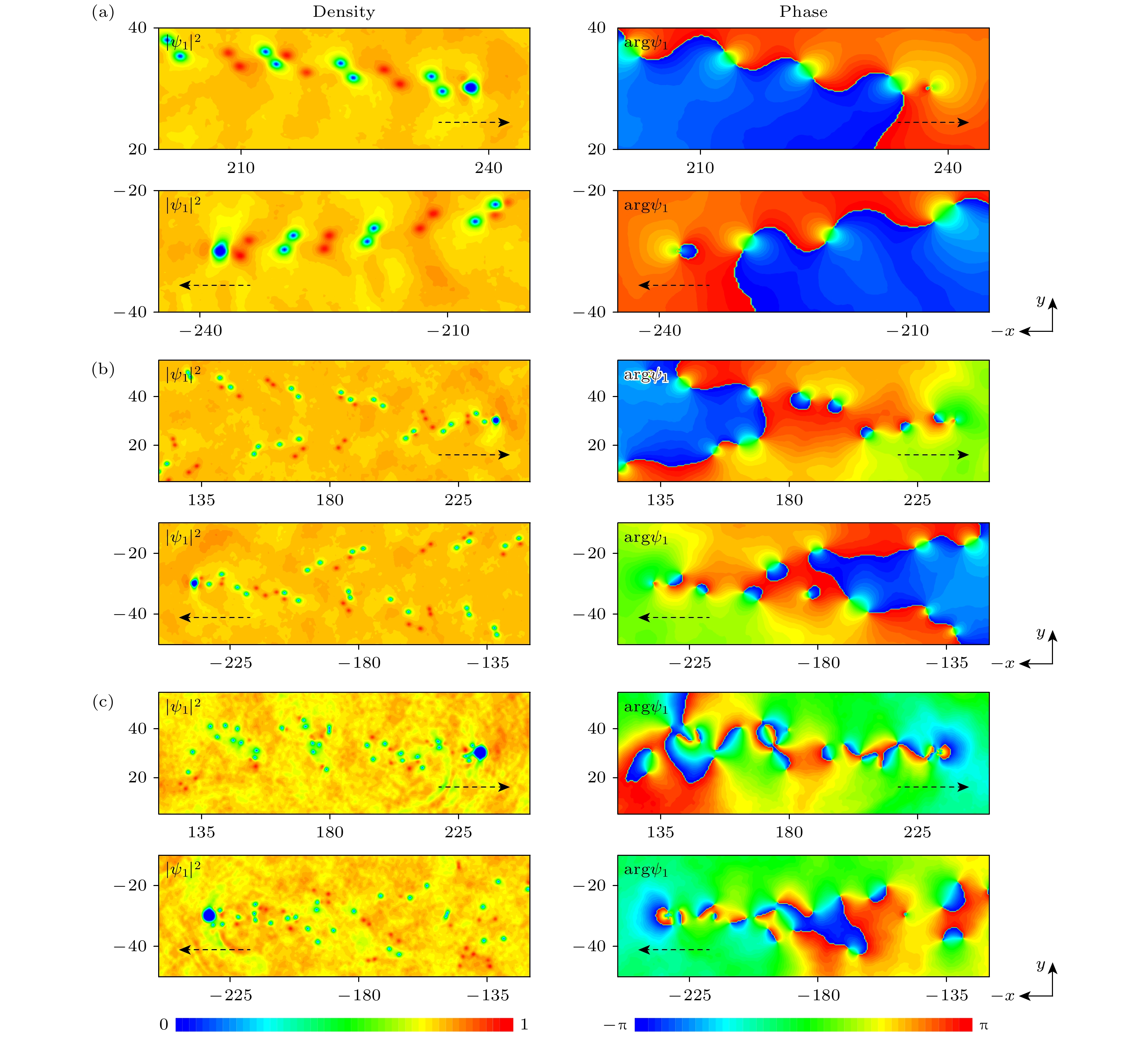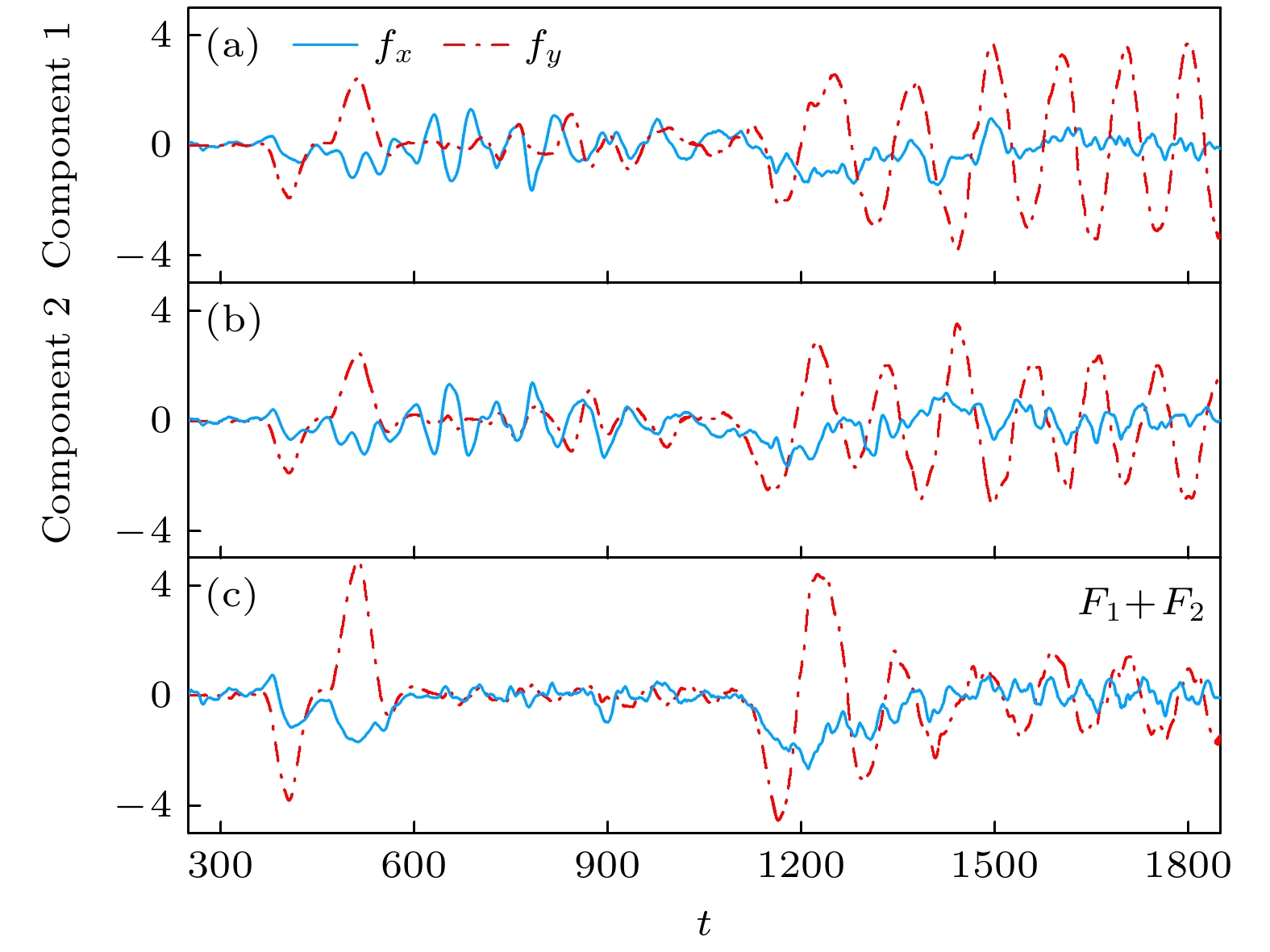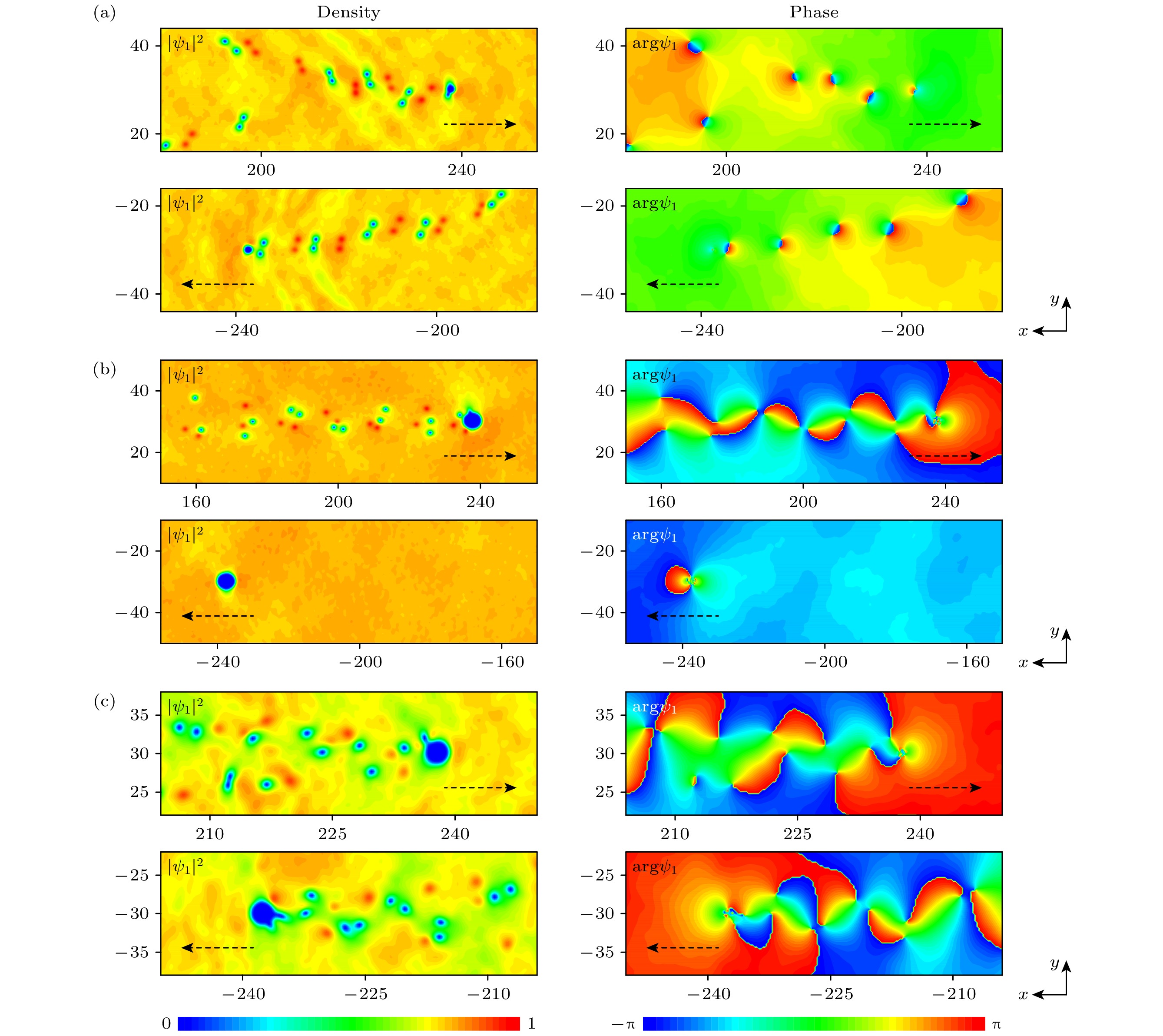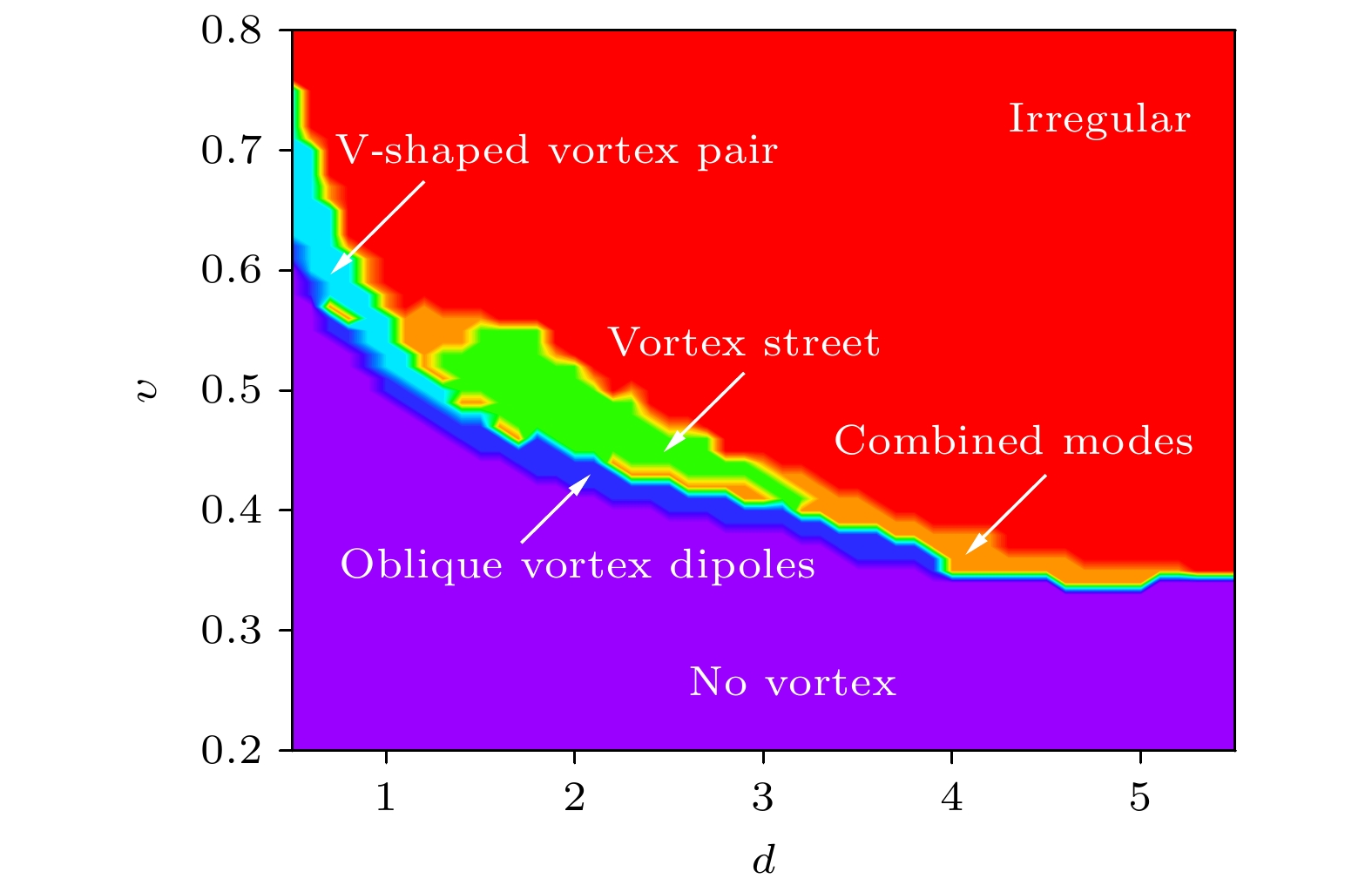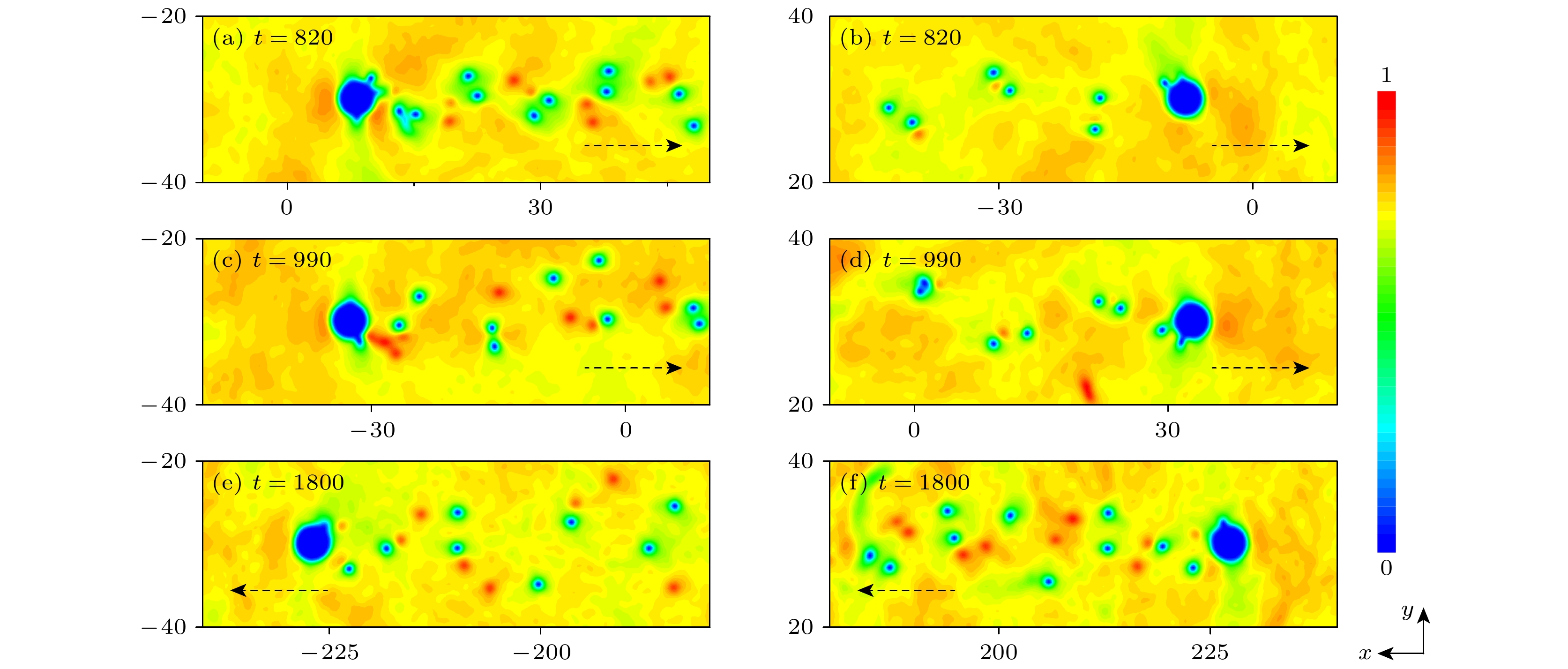-
数值研究了相混合态双组分玻色-爱因斯坦凝聚体(Bose-Einstein condensate, BEC)中PT (parity-time)对称势下的动力学. 在障碍势不同的宽度和速度下发现了异步量子Kármán涡街、斜向漂移涡旋偶极子、V字形涡旋对、无规则量子湍流以及各种尾迹的组合模式. 研究了作用在移动障碍势上的拖拽力, 分析了涡旋对产生的力学机理. 在不同障碍势宽度和速度下, 系统地模拟了异步量子Kármán涡街和其他尾迹模式的参数区域. 同样分析了PT对称势中具有增益-损耗强度的虚部对异步量子Kármán涡街稳定性的影响. 最后, 提供了一个实现异步量子Kármán 涡街的实验方案.
-
关键词:
- 玻色-爱因斯坦凝聚体 /
- Kármán涡街 /
- PT对称势
The dynamics of a miscible two-component Bose-Einstein condensate (BEC) with PT (parity-time) symmetric potential are investigated numerically. The dynamical behaviors of the system is described by Gross-Pitaevskii (GP) equations under the mean-field theory. Firstly, the ground state of the system is obtained by the imaginary-time propagation method. Then dynamical behaviors are numerically simulated by the time-splitting Fourier pseudo-spectral approach under periodic boundary conditions. By adjusting the width and velocity of the obstacle potential, various patterns such as no vortex, oblique drifting vortex dipole, V-shaped vortex pairs, irregular quantum turbulence and combined modes are studied. It is noted that the shedding vortex pairs in components 1 and 2 are staggered, which is called “the asynchronous quantum Kármán vortex street”. Here, the ratio of the distance between two vortex pairs in one row to the distance between vortex rows is approximately 0.18, which is less than the stability criterion 0.28 of classical fluid. We calculated the drag force acting on the obstacle potential during generation of the asynchronous quantum Kármán vortex street. It is found that periodical oscillation of the drag force is generated via drifting up or down of the vortex pairs. Meanwhile, we analyzed the influence of the imaginary part of the PT symmetric potential with gain-loss for wake. The trajectory and frequency of the vortex are changed, due to the imaginary part breaks the local symmetry of the system. In addition, the imaginary part affects the stability of the asynchronous quantum Kármán vortex street. Lots of numerical simulations are carried out to determine the parameter regions of various vortex shedding modes. We also proposed an experimental protocol to realize the asynchronous quantum Kármán vortex street in the miscible two-component BEC with PT symmetric potential.[1] Bose V 1924 Zeitschrift für Physik 26 178
 Google Scholar
Google Scholar
[2] Anderson M H, Ensher J R, Matthews M R, Wieman C E, Cornell E A 1995 Science 269 198
 Google Scholar
Google Scholar
[3] Edwards M, Dodd R J, Clark C W, Ruprecht P A, Burnett K 1996 Phys. Rev. A 53 R1950
 Google Scholar
Google Scholar
[4] Davis K B, Mewes M O, Andrews M R, van Druten N J, Durfee D S, Kurn D M, Ketterle W 1995 Phys. Rev. Lett. 75 3969
 Google Scholar
Google Scholar
[5] Jackson B, McCann J F, Adams C S 1998 Phys. Rev. Lett. 80 3903
 Google Scholar
Google Scholar
[6] Zhu Q L, Pan L 2021 J. Low Temp. Phys. 203 392
 Google Scholar
Google Scholar
[7] Sasaki K, Suzuki N, Saito H 2010 Phys. Rev. Lett 104 150404
 Google Scholar
Google Scholar
[8] Schoepe W 2015 JETP Lett. 102 105
 Google Scholar
Google Scholar
[9] Li X L, Yang X Y, Tang N, Song L, Zhou Z K, Zhang J, Shi Y R 2019 New J. Phys. 21 103046
 Google Scholar
Google Scholar
[10] 王力, 刘静思, 李吉, 周晓林, 陈向荣, 刘超飞, 刘伍明 2020 物理学报 69 010303
 Google Scholar
Google Scholar
Wang L, Liu J S, Li J, Zhou X L, Chen X R, Liu C F, Liu W M 2020 Acta Phys. Sin. 69 010303
 Google Scholar
Google Scholar
[11] Zhang T F, Li C X, Liu W M 2023 Chin. Phys. B 32 090501
 Google Scholar
Google Scholar
[12] 文林, 梁毅, 周晶, 余鹏, 夏雷, 牛连斌, 张晓斐 2019 物理学报 68 080301
 Google Scholar
Google Scholar
Wen L, Liang Y, Zhou J, Yu P, Xia L, Niu L B, Zhang X F 2019 Acta Phys. Sin. 68 080301
 Google Scholar
Google Scholar
[13] Nore C, Huepe C, Brachet M E 2000 Phys. Rev. Lett. 84 2191
 Google Scholar
Google Scholar
[14] Aftalion A, Du Q, Pomeau Y 2003 Phys. Rev. Lett. 91 090407
 Google Scholar
Google Scholar
[15] Qi W, Guo X G, Dong L W, Zhang X F 2023 Chin. Phys. B 32 030502
 Google Scholar
Google Scholar
[16] Okulov V L, Fukumoto Y 2021 J. Appl. Mech. Tech. Phys. 62 519
 Google Scholar
Google Scholar
[17] Abo-Shaeer J R, Raman C, Vogels J M, Ketterle W 2001 Science 292 476
 Google Scholar
Google Scholar
[18] Kim Ildoo, Wu X L 2015 Phys. Rev. E 92 043011
 Google Scholar
Google Scholar
[19] Ponta F L, Aref H 2004 Phys. Rev. Lett. 93 084501
 Google Scholar
Google Scholar
[20] Finne A P, Araki T, Blaauwgeers R, Eltsov V B, Kopnin N B, Krusius M, Skrbek L, Tsubota M, Volovik G E 2003 Nature 424 1022
 Google Scholar
Google Scholar
[21] Sasaki K, Suzuki N, Saito H 2011 Phys. Rev. A 83 033602
 Google Scholar
Google Scholar
[22] Kwon W J, Kim J H, Seo S W, Shin Y 2016 Phys. Rev. A 117 245301
 Google Scholar
Google Scholar
[23] Bender C M, Boettcher S 1998 Phys. Rev. Lett. 117 5243
 Google Scholar
Google Scholar
[24] Single F, Cartarius H, Wunner G, Main J 2014 Phys. Rev. A 90 042123
 Google Scholar
Google Scholar
[25] Hussain J, Nouman M, Saif F, Akram J 2020 Physica B 587 412152
 Google Scholar
Google Scholar
[26] Guo P, Gasparian V, Jódar E, Wisehart, C 2023 Phys. Rev. A 107 032210
 Google Scholar
Google Scholar
[27] Bender C M, Boettcher S, Meisinger P N 1999 J. Math. Phys. 40 2201
 Google Scholar
Google Scholar
[28] Rüter C E, Makris K G, El-Ganainy R, Christodoulides D N, Segev M, Kip Dm 2010 Nat. Phys. 6 192
 Google Scholar
Google Scholar
[29] Bender C M, Gianfreda M, Özdemir S K, Peng B, Yang L 2013 Phys. Rev. A 88 062111
 Google Scholar
Google Scholar
[30] Guo A, Salamo G J, Duchesne D, Morandotti R, Volatier-Ravat M, Aimez V, Siviloglou G A, Christodoulides D N 2009 Phys. Rev. Lett. 103 093902
 Google Scholar
Google Scholar
[31] Wilkey A, Suelzer J, Joglekar Y, Vemuri G 2019 Photonics 6 122
 Google Scholar
Google Scholar
[32] Schwarz L, Cartarius H, Musslimani Z H, Main J, Wunner G 2017 Phys. Rev. A 95 053613
 Google Scholar
Google Scholar
[33] Haag D, Dast D, Löhle, A, Cartarius H, Main J, Wunner G 2014 Phys. Rev. A 89 023601
 Google Scholar
Google Scholar
[34] Kato M, Zhang X F, Saito H 2017 Phys. Rev. A 95 043605
 Google Scholar
Google Scholar
[35] Cui X L 2022 Phys. Rev. Res. 4 013047
 Google Scholar
Google Scholar
[36] Wang L X, Dai C Q, Wen L, Liu T, Jiang H F, Saito H, Zhang S G, Zhang, X F 2018 Phys. Rev. A 97 063607
 Google Scholar
Google Scholar
[37] Zhang X F, Du Z J, Tan R B, Dong R F, Chang H, Zhang S G 2014 Ann. Phys. 346 154
 Google Scholar
Google Scholar
[38] Hu X H, Zhang X F, Zhao D, Luo H G, Liu W M 2009 Phys. Rev. A 79 023619
 Google Scholar
Google Scholar
[39] Fujiyama S, Tsubota M 2009 Phys. Rev. B 79 094513
 Google Scholar
Google Scholar
[40] Williamson C H K 1996 Annu. Rev. Fluid Mech. 28 477
 Google Scholar
Google Scholar
[41] Mason P 2013 Phys. Rev. A 88 043608
 Google Scholar
Google Scholar
[42] Barenghi C F 2008 Physica D 237 2195
 Google Scholar
Google Scholar
[43] Papp S B, Wieman C E 2006 Phys. Rev. Lett. 97 180404
 Google Scholar
Google Scholar
[44] Papp S B, Pino J M, Wieman C E 2008 Phys. Rev. Lett. 101 040402
 Google Scholar
Google Scholar
[45] Kwon W J, Moon G, Choi J, Seo S W, Shin Y 2014 Phys. Rev. A 90 063627
 Google Scholar
Google Scholar
[46] Werner J, Griesmaier A, Hensler S, Stuhler J, Pfau T 2005 Phys. Rev. Lett. 94 183201
 Google Scholar
Google Scholar
[47] Robins N P, Figl C, Jeppesen M, Dennis G R, Close J D 2008 Nat. Phys. 4 731
 Google Scholar
Google Scholar
[48] Li J, Harter A K, Liu J, Melo L, Joglekar Y N, Luo L 2019 Nature 10 855
 Google Scholar
Google Scholar
-
图 1 PT对称势下异步量子Kármán涡街的密度分布$ {|\psi_1 |}^2 $, $ {|\psi_2 |}^2 $, $ {|\psi_1 |}^2+{|\psi_2 |}^2 $, $ {|\psi_2 |}^2-{|\psi_1 |}^2 $ 和相位分布 arg$ \psi_1 $, arg$ \psi_2 $. 障碍势的宽度和速度为$ (d, \upsilon)=(1.9, 0.46) $. 黑色虚线箭头表示障碍势的移动方向
Fig. 1. Density $ {|\psi_1 |}^2 $, $ {|\psi_2 |}^2 $, $ {|\psi_1 |}^2+{|\psi_2 |}^2 $, $ {|\psi_2 |}^2-{|\psi_1 |}^2 $ and phase arg$ \psi_1 $, arg$ \psi_2 $ distributions of asynchronous quantum Kármán vortex street with PT symmetric potential. The width and velocity of the obstacle potential is $ (d, \upsilon)=(1.9, 0.46) $. The dashed black arrow indicates the direction of the moving obstacle potential.
图 2 PT对称势下不同尾迹的密度分布$ {|\psi_1 |}^2 $和相位分布arg$ \psi_1 $. 黑色虚线箭头表示障碍势的移动方向 (a) $ d=0.7, \upsilon=0.56 $; (b) $ d=1.1, \upsilon=0.51 $; (c) $ d=2.1, \upsilon=0.53 $
Fig. 2. Density $ {|\psi_1 |}^2 $ and phase arg$ \psi_1 $ distributions of various wakes with PT symmetric potential. The dashed black arrow indicates the direction of the moving obstacle potential: (a) $ d=0.7, \upsilon=0.56 $; (b) $ d=1.1, \upsilon=0.51 $; (c) $ d=2.1, \upsilon=0.53 $.
图 3 异步量子Kármán涡街形成过程中作用在移动障碍势上的拖拽力随时间的演化. 蓝色实线和红色虚线表示$ f_x $和$ f_y $. F1+F2代表双组分中产生的拖拽力. 参数与图1所取参数一致
Fig. 3. Time evolution of the drag force acting on the moving obstacle potential during the formation of asynchronous quantum Kármán vortex street. Solid blue lines and dotted red lines represent $ f_x $ and $ f_y $. F1+F2 denotes drag force of the two-component. The parameters are consistent with Fig. 1.
图 4 PT对称势下组合模式的密度分布$ {|\psi_1 |}^2 $和相位分布arg$ \psi_1 $. 黑色虚线箭头表示障碍势的移动方向 (a) $ d=0.7, \upsilon=0.57 $; (b) $ d=2.3, \upsilon=0.43 $; (c) $ d=1.3, \upsilon=0.55 $
Fig. 4. Density $ {|\psi_1 |}^2 $ and phase arg$ \psi_1 $ distributions of combined modes with PT symmetric potential. The dashed black arrow indicates the direction of the moving obstacle potential: (a) $ d=0.7, \upsilon=0.57 $; (b) $ d=2.3, \upsilon=0.43 $; (c) $ d=1.3, \upsilon=0.55 $.
图 5 作用在移动障碍势上的拖拽力随时间的演化. (a)—(c)参数与图4(b)一致和(d)—(f)参数与图4(c)一致
Fig. 5. Time evolution of the drag force acting on the moving obstacle potential. The parameters of (a)–(c) and (d)–(f) are consistent with Figs. 4(b) and (c), respectively
图 6 各种典型尾迹模式与移动障碍势的宽度d和速度$ \upsilon $的关系. 紫色区域表示稳定的层流, 蓝色、浅蓝色、红色、绿色和橙色区域对应图2(a)—(c)、图1和图4
Fig. 6. Dependence of the various wake patterns on the width d and velocity $ \upsilon $ of moving obstacle potential. The purple area is consistent with the stable laminar flow. The blue, light blue, red, green and orange areas correspond to the wake patterns shown in Figs. 2(a)-(c), Fig. 1 and Fig. 4
-
[1] Bose V 1924 Zeitschrift für Physik 26 178
 Google Scholar
Google Scholar
[2] Anderson M H, Ensher J R, Matthews M R, Wieman C E, Cornell E A 1995 Science 269 198
 Google Scholar
Google Scholar
[3] Edwards M, Dodd R J, Clark C W, Ruprecht P A, Burnett K 1996 Phys. Rev. A 53 R1950
 Google Scholar
Google Scholar
[4] Davis K B, Mewes M O, Andrews M R, van Druten N J, Durfee D S, Kurn D M, Ketterle W 1995 Phys. Rev. Lett. 75 3969
 Google Scholar
Google Scholar
[5] Jackson B, McCann J F, Adams C S 1998 Phys. Rev. Lett. 80 3903
 Google Scholar
Google Scholar
[6] Zhu Q L, Pan L 2021 J. Low Temp. Phys. 203 392
 Google Scholar
Google Scholar
[7] Sasaki K, Suzuki N, Saito H 2010 Phys. Rev. Lett 104 150404
 Google Scholar
Google Scholar
[8] Schoepe W 2015 JETP Lett. 102 105
 Google Scholar
Google Scholar
[9] Li X L, Yang X Y, Tang N, Song L, Zhou Z K, Zhang J, Shi Y R 2019 New J. Phys. 21 103046
 Google Scholar
Google Scholar
[10] 王力, 刘静思, 李吉, 周晓林, 陈向荣, 刘超飞, 刘伍明 2020 物理学报 69 010303
 Google Scholar
Google Scholar
Wang L, Liu J S, Li J, Zhou X L, Chen X R, Liu C F, Liu W M 2020 Acta Phys. Sin. 69 010303
 Google Scholar
Google Scholar
[11] Zhang T F, Li C X, Liu W M 2023 Chin. Phys. B 32 090501
 Google Scholar
Google Scholar
[12] 文林, 梁毅, 周晶, 余鹏, 夏雷, 牛连斌, 张晓斐 2019 物理学报 68 080301
 Google Scholar
Google Scholar
Wen L, Liang Y, Zhou J, Yu P, Xia L, Niu L B, Zhang X F 2019 Acta Phys. Sin. 68 080301
 Google Scholar
Google Scholar
[13] Nore C, Huepe C, Brachet M E 2000 Phys. Rev. Lett. 84 2191
 Google Scholar
Google Scholar
[14] Aftalion A, Du Q, Pomeau Y 2003 Phys. Rev. Lett. 91 090407
 Google Scholar
Google Scholar
[15] Qi W, Guo X G, Dong L W, Zhang X F 2023 Chin. Phys. B 32 030502
 Google Scholar
Google Scholar
[16] Okulov V L, Fukumoto Y 2021 J. Appl. Mech. Tech. Phys. 62 519
 Google Scholar
Google Scholar
[17] Abo-Shaeer J R, Raman C, Vogels J M, Ketterle W 2001 Science 292 476
 Google Scholar
Google Scholar
[18] Kim Ildoo, Wu X L 2015 Phys. Rev. E 92 043011
 Google Scholar
Google Scholar
[19] Ponta F L, Aref H 2004 Phys. Rev. Lett. 93 084501
 Google Scholar
Google Scholar
[20] Finne A P, Araki T, Blaauwgeers R, Eltsov V B, Kopnin N B, Krusius M, Skrbek L, Tsubota M, Volovik G E 2003 Nature 424 1022
 Google Scholar
Google Scholar
[21] Sasaki K, Suzuki N, Saito H 2011 Phys. Rev. A 83 033602
 Google Scholar
Google Scholar
[22] Kwon W J, Kim J H, Seo S W, Shin Y 2016 Phys. Rev. A 117 245301
 Google Scholar
Google Scholar
[23] Bender C M, Boettcher S 1998 Phys. Rev. Lett. 117 5243
 Google Scholar
Google Scholar
[24] Single F, Cartarius H, Wunner G, Main J 2014 Phys. Rev. A 90 042123
 Google Scholar
Google Scholar
[25] Hussain J, Nouman M, Saif F, Akram J 2020 Physica B 587 412152
 Google Scholar
Google Scholar
[26] Guo P, Gasparian V, Jódar E, Wisehart, C 2023 Phys. Rev. A 107 032210
 Google Scholar
Google Scholar
[27] Bender C M, Boettcher S, Meisinger P N 1999 J. Math. Phys. 40 2201
 Google Scholar
Google Scholar
[28] Rüter C E, Makris K G, El-Ganainy R, Christodoulides D N, Segev M, Kip Dm 2010 Nat. Phys. 6 192
 Google Scholar
Google Scholar
[29] Bender C M, Gianfreda M, Özdemir S K, Peng B, Yang L 2013 Phys. Rev. A 88 062111
 Google Scholar
Google Scholar
[30] Guo A, Salamo G J, Duchesne D, Morandotti R, Volatier-Ravat M, Aimez V, Siviloglou G A, Christodoulides D N 2009 Phys. Rev. Lett. 103 093902
 Google Scholar
Google Scholar
[31] Wilkey A, Suelzer J, Joglekar Y, Vemuri G 2019 Photonics 6 122
 Google Scholar
Google Scholar
[32] Schwarz L, Cartarius H, Musslimani Z H, Main J, Wunner G 2017 Phys. Rev. A 95 053613
 Google Scholar
Google Scholar
[33] Haag D, Dast D, Löhle, A, Cartarius H, Main J, Wunner G 2014 Phys. Rev. A 89 023601
 Google Scholar
Google Scholar
[34] Kato M, Zhang X F, Saito H 2017 Phys. Rev. A 95 043605
 Google Scholar
Google Scholar
[35] Cui X L 2022 Phys. Rev. Res. 4 013047
 Google Scholar
Google Scholar
[36] Wang L X, Dai C Q, Wen L, Liu T, Jiang H F, Saito H, Zhang S G, Zhang, X F 2018 Phys. Rev. A 97 063607
 Google Scholar
Google Scholar
[37] Zhang X F, Du Z J, Tan R B, Dong R F, Chang H, Zhang S G 2014 Ann. Phys. 346 154
 Google Scholar
Google Scholar
[38] Hu X H, Zhang X F, Zhao D, Luo H G, Liu W M 2009 Phys. Rev. A 79 023619
 Google Scholar
Google Scholar
[39] Fujiyama S, Tsubota M 2009 Phys. Rev. B 79 094513
 Google Scholar
Google Scholar
[40] Williamson C H K 1996 Annu. Rev. Fluid Mech. 28 477
 Google Scholar
Google Scholar
[41] Mason P 2013 Phys. Rev. A 88 043608
 Google Scholar
Google Scholar
[42] Barenghi C F 2008 Physica D 237 2195
 Google Scholar
Google Scholar
[43] Papp S B, Wieman C E 2006 Phys. Rev. Lett. 97 180404
 Google Scholar
Google Scholar
[44] Papp S B, Pino J M, Wieman C E 2008 Phys. Rev. Lett. 101 040402
 Google Scholar
Google Scholar
[45] Kwon W J, Moon G, Choi J, Seo S W, Shin Y 2014 Phys. Rev. A 90 063627
 Google Scholar
Google Scholar
[46] Werner J, Griesmaier A, Hensler S, Stuhler J, Pfau T 2005 Phys. Rev. Lett. 94 183201
 Google Scholar
Google Scholar
[47] Robins N P, Figl C, Jeppesen M, Dennis G R, Close J D 2008 Nat. Phys. 4 731
 Google Scholar
Google Scholar
[48] Li J, Harter A K, Liu J, Melo L, Joglekar Y N, Luo L 2019 Nature 10 855
 Google Scholar
Google Scholar
计量
- 文章访问数: 3603
- PDF下载量: 59
- 被引次数: 0













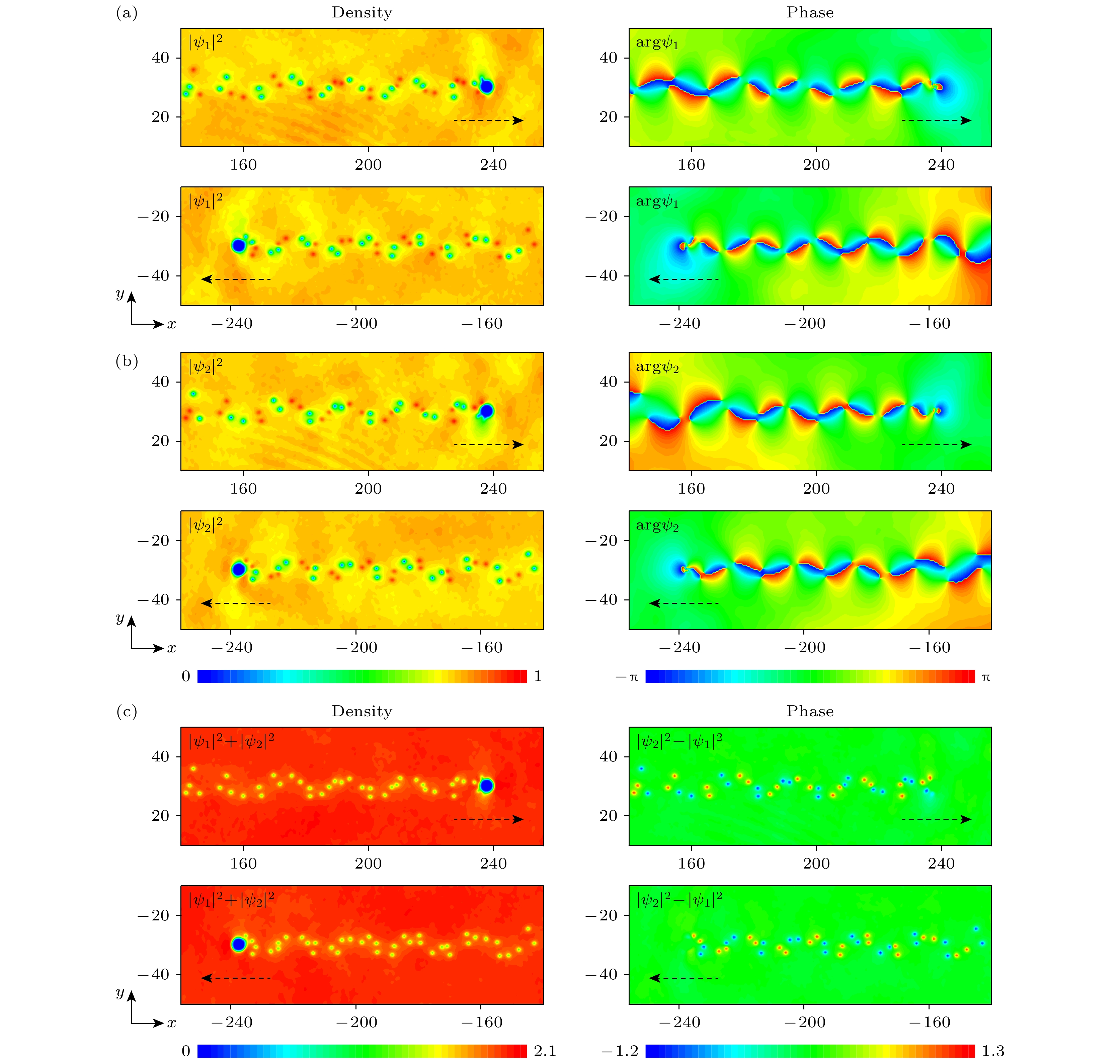
 下载:
下载:
